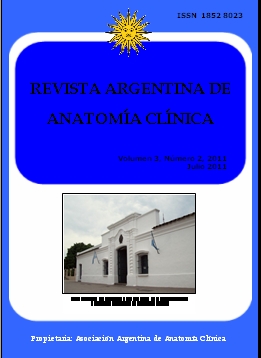ESTUDIO MORFOLÓGICO DEL PTERION Y ASTERION EN CRÁNEOS ADULTOS MEXICANOS. Estudio morfológico del pterion y asterion en cráneos adultos mexicanos
DOI:
https://doi.org/10.31051/1852.8023.v3.n2.13923Palabras clave:
pterion, asterion, cráneo, morfometría, sutura, skull, morphometry, sutureResumen
Introducción. El pterion y asterion son puntos craneométricos de confluencia sutural observables en una vista lateral del cráneo, ambos representan puntos de referencia y/o acceso dentro del campo de la neurocirugía así como puntos de importancia dentro de la antropología física y medicina legal por sus diferencias morfológicas entre las diferentes poblaciones. Materiales y Métodos. Se examinaron ochenta y cinco cráneos secos de adultos mexicanos bilateralmente, se obtuvieron las distancias promedio entre el centro del pterion y el borde posterior de la sutura frontocigomática, borde superior del arco cigomático, base de la fosa mandibular, vértice de la apófisis mastoides y el centro del asterion. Resultados. Se identificaron cuatro tipos de pterion: esfenoparietal (90%), estellar (4.12%), epiptérico (3.53%) y frontotemporal (2.35%). Se identificaron dos tipos de asterion: tipo 1 (7.06%) y tipo 2 (92.94%). Conclu-siones. Los resultados obtenidos en la morfología sutural de ambos puntos y los resultados de las mediciones son de importancia para el abordaje neuroquirúrgico del cráneo, patólogos forenses y antropólogos.
Introduction. Pterion and asterion are craniometrical landmarks of sutural confluence observable in a lateral view of the skull. Both represent points of reference and/or access in the field of neurosurgery, and are aspects of importance in disciplines such as physical anthropology and legal medicine for the morphological differences between the different populations. Materials and Methods. Examinations were conducted bilaterally in 85 (eighty five) dry skulls from Mexican adults. The average distances were obtained from the center of the pterion to the following landmarks: posterior edge of the frontozygomatic suture, superior edge of the zygomatic arch, base of the mandibular fossa, vertex of the mastoid process and the center of the asterion. Results. Four types of pterion were identified: sphenoparietal (90%), stellar (4.12%), epipteric (3.53%) and frontotemporal (2.35%). Two types of asterion were identified: type 1 (7.06%) and type 2 (92.94%). Conclusions. The results obtained in the analysis of the sutural morphology of both landmarks and the results of the measurements are of importance for the neurosurgical access of the skull, and are as well relevant to forensic pathologists and anthropologists.
Referencias
Asala SA, Mbajiorgu FE. 1996. Epigenetic variation in the Nigerian skull: sutural pattern at the pterion. East Afr Medical Journal 73: 484-86.
Berry AC, Berry RJ. 1967. Epigenetic variation in the human cranium. J Anat 101: 361-379.
Braga MTT, Gabrielli C, De Souza A, Rodríguez CFS, Marino JC. 2000. Huesos suturales en el pterion. Rev Chil Anat 18: 10-17.
Ersoy M, Evliyaoglu C, Bozkurt M. 2003. Epipteric bones in the pterion may be a surgical pitfall. MIN 46: 363-65.
Feng WF, Qi ST, Huang SP, Huang LJ. 2005. Surgical treatment of anterior circulation aneurysm via pterion keyhole approach. Di Yi Jun Yi Da Xue Xue Bao 25: 546-48.
Gumusburun E, Sevim A, Katkici U, Adiguzel E, Gulec E. 1997. A study of sutural bones in Anatolian-Ottoman skulls. Int J Anthropol 12: 43-48.
Hussain Saheb S, Mavishetter GF,Thomas ST, Prasanna LC, Muralidhar P. 2011. A study of sutural morphology among human adult Indian skulls. Biomed Research 22: 73-75.
Iknur A, Ilker M, Sinan B. 2002 A comparative study of variation of the pterion of human skulls from 13 th and 20 th century Anatolia. Int J Morphol 27: 1291-98.
Kellock WL, Parsons PA. 1970. A comparison of the incidenceof minor nonmetrical cranial variants in Australian Aborigines with those of Melanesia and Polynesia. AJPA 33: 235-39.
Martínez F, Laxague A, Vida L, Prinzo H, Sgarbi N, Soria V.R, Bianchi C. 2005. Anatomía topográfica del asterion. Neurocirugía 16: 441-46.
Matsumara G, Kida K, Ichikawa R, Kodama G. 1991. Pterion and epipteric bones in Japanese adults and fetuses with special reference to their formation and variations. Acta Anatomica Nipponica 66: 462-71.
Murphy T. 1956. The pterion in Australian Aborigine. AJPA 14: 225-44.
Mwachaka PM, Hassanali J, Odula P. 2009. Sutural morphology of the pterion and asterion among adult kenyans. Braz J Morphol Sci 26: 4-7.
Oguz O, Sanli SG, Bozkir MG, Soames RW. 2004. The pterion in Turkish male skulls. Surg Radiol Anat 26: 220-24.
Saxena RC, Bilodi AKS, Mane SS, Kumar A. 2003. Study of pterion in skulls of awadh area-in and around Lucknow. KUMJ 1: 32-33.
Zalawadia A, Vadgama J, Ruparelia S, Patel S, Rathod SP, Patel SV. 2010. Morphometric study of pterion in dry skull of guajarat region. NJIRM 1: 25-29.
Descargas
Publicado
Número
Sección
Licencia
Los autores/as conservarán sus derechos de autor y garantizarán a la revista el derecho de primera publicación de su obra, el cuál estará simultáneamente sujeto a la Licencia de reconocimiento de Creative Commons que permite a terceros compartir la obra siempre que se indique su autor y su primera publicación en esta revista. Su utilización estará restringida a fines no comerciales.
Una vez aceptado el manuscrito para publicación, los autores deberán firmar la cesión de los derechos de impresión a la Asociación Argentina de Anatomía Clínica, a fin de poder editar, publicar y dar la mayor difusión al texto de la contribución.



